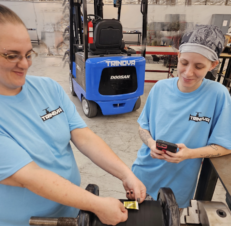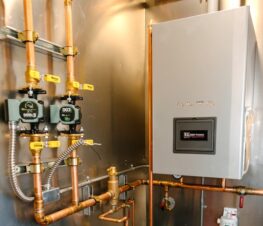By Rich Grimes
Water Solutions Marketing
I am constantly asked questions from contractors related to water heating and water systems. In this issue I will address some Frequently Asked Questions that come up more often than others.
1) What is the most efficient way to heat water – Gas or Electricity?
Electricity is more available to consumers than Natural or Propane Gas. Natural gas is an interconnected system of piping that services certain areas. Customers have access to Propane if Natural is not available in their area.
As far as efficiency, Electric resistance immersion heating is 98% efficient. Gas-fired appliances have efficiencies ranging from about 80% all the way up to 98%. The best answer to this question is Electricity is more efficient with a higher energy cost. Gas is typically less efficient but has a lower energy cost. The lower efficiency gas-fired heater costs less to operate than a comparable electric model. The new Hybrid Heat Pump heaters are the least expensive way to heat water if you are comparing them to a standard tank-type heater with either electric or gas input.
2) What about the Hybrid Heat Pump water heaters? Are they a viable option to heat water with electricity?
Absolutely – The Heat Pump water heaters use approximately one-half of the electricity of a standard electric water heater. Instead of using a 4500 Watt element to heat the tank, a dedicated heat pump can generate plenty of hot water with its 850 Watt heat pump assembly.
There are many benefits to using a heat pump. Many electric providers offer rebates for replacing standard electric water heaters with Heat Pump technology.
3) What are the benefits of using Tankless water heaters?
Tankless gas and electric products are flow-activated and do not heat any water (or use fuel) when hot water is not being used. They do not experience any of the stand-by losses associated with a tank-type heater. The other key features are wall mounting, compact size and continuous hot water on demand.
The electric models are better suited to point-of-use at the fixture and can be located under a sink, on a wall or in a cabinet. The gas-fired tankless heaters have more output and can handle large loads. They also can be linked together to create modular systems with multiple heaters for even larger hot water loads.
4) What is the main cause of water heater failure?
Lime scale build-up on heating surfaces is the most common contributor to heater and tank failure. It is also the reason that heaters use more energy over time. As the heating surface accumulates more film thickness of scale, it requires more energy to heat the water through the scale. A gas-fired heater must keeps its burner on longer and an electric heater must keep its elements on longer to heat the same amount of water, through the lime scale insulator. The combination of metal stress and fatigue and long burner cycles caused by scale build-up will cause premature failure.
5) Can a water heater be descaled to prevent premature failure?
Scale is very hard to remove on a tank-type heater. The commercial tank-type heaters can accumulate quite a bit of precipitated calcium carbonate.
Tankless and coil type heaters can be cleaned to remove the lime scale. A small pump with a bucket of vinegar can circulate the heat exchanger until the scale build-up has been removed. There are also specific non-toxic cleaning solutions that are available to clean copper coils and heat exchangers like citric acid.
The descaling process is much more complicated on gas tank-type heaters and is rarely performed on them. On electric heaters, the scale builds up on the elements and does precipitate into the tank. An electric heater can be blown down at the drain valve and have the elements cleaned or replaced, which is a typical tune-up.
6) How can a gas-fired appliance be able to be vented with plastic vent pipe such as PVC or CPVC?
PVC piping is rated for a maximum temperature rating of 140°F and CPVC is rated for 180°F. These temperatures are much lower than the actual combustion exhaust temperature.
There are two predominant methods that are utilized to allow for plastic venting on gas heaters:
The first method is air dilution where a fan-assisted vent assembly with allow cooler ambient air to mix with the combustion exhaust. This method is commonly seen on residential Power Vent water heaters.
The second method that is more common is a High Efficiency appliance that uses an exhaust heat exchanger to preheat the incoming cold water or a multi-pass flue assembly. As cold water flows through the exhaust heat exchanger or across the multi-pass flue, the exhaust temperature drops and the efficiency goes up! These heaters are rated above 85% and usually in the 90%+ efficiency range, extracting almost all of the latent heat from the combustion process. The by-product of the high efficiency exhaust is water vapor that condenses and requires removal from the heater and vent system typically by a condensate trap assembly.
There is some contention on the use of plastic piping for heater exhaust. It should be noted that heaters are produced with various safety controls including exhaust high limits, vent sensors and pressure proving switches. These devices insure that the heater will be disabled if a high exhaust temperature is sensed. This will protect the plastic exhaust piping until the condition can be rectified.
Another important note regarding plastic venting would be to always use PVC or CPVC Schedule 40 or 80 solid-core pipe and pressure rated fittings. NEVER use foam-core pipe on a sealed vent exhaust system. Other plastic piping materials such as Polypropylene have higher temperature ratings and can be used for sealed venting but they can be cost prohibitive. Sealed SS Category III and IV vent pipe also are rated for use on high efficiency appliances so they are an option where piping may run through a return air plenum.
7) What are the essential considerations to perform a successful installation of a Gas water heater?
Every gas appliance installer should have an understanding of the unit’s requirements in the following areas:
a) GAS SUPPLY – verify gas type, BTU inputs, pipe sizing, pressure regulation, etc.
b) COMBUSTION AND VENTILATION AIR – verify gravity air intake or Direct Air requirements specific to the installation, per manufacturers specifications and NFGC/NFPA54.
c) EXHAUST SYSTEM – verify approved vent material, vent lengths and termination. Verify that the vent route does not conflict with clearances, existing code or other trades.
d) ELECTRICAL – verify required voltage, polarity, disconnects, breakers, etc. Most electronic heater controls require 120V which is stepped down to 24VAC for the safety controls. Hot Surface Ignition systems typically use 120V to heat up the igniter.
There are other aspects of a gas heater installation that are also important such as clearances from combustibles. A little planning goes a long way! Read the instructions!
8) Do I need an Expansion Tank on my water heater?
Expansion tanks are designed to absorb thermal expansion created when heating water. If you have a check valve or backflow device located near the water heater you will need an Expansion Tank. These positive shut-off check valves will not allow expanding water to go anywhere. The heater tank must absorb the expansion which leads to premature tank failure. A relief valve that opens at the end of a heating cycle is a definite sign of the need for expansion control.
The answer is that an expansion tank or device may or may not be required but it is always a good idea. It greatly reduces vessel stress and prolongs water heater life. It is very important on commercial heaters that have high volumes of expansion.
9) My old heater was 12 years old and I never needed an expansion tank. Why do I need one now with this brand new water heater?
This is more common than you might think. The old heater was scaled up and had a long heating cycle. The expansion is spread out over that long heating cycle. The new heater has a clean heating surface and a much quicker recovery time. This cycle can be half as long as the old heater due to lime scale build-up. The expansion occurs much quicker than the old heater.
This is why expansion control is so important on commercial heaters. An atmospheric heater rated at 500,000 BTU with an 85 gallon tank can recover approximately 480 GPH and raise the temperature 100°F. But wait, 480 GPH ÷ 85 Gallons = 5.65 Minutes… In less than 6 minutes the burner can raise the tank temperature from 60°F up to 160°F! That is rapid expansion that will stress a commercial heater each time the burner fires.
This has been a little different format but I hope you got something out of it. We are always open to questions so please let us know of any issues or topics that we could discuss.
Thanks and we’ll see you in a future article!
Rich Grimes




Join the conversation: